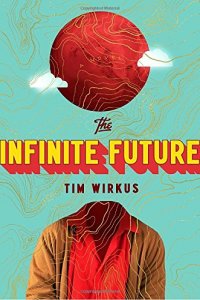Paul Di Filippo reviews Tim Wirkus’s The Infinite Future
The Infinite Future, by Tim Wirkus (Penguin Press 978-0-7352-2432-2, $28, 400pp, hardcover) January 2018
 The concept of “steam engine time” should be familiar to most SF readers. The notion derives from a line by Charles Fort in his book Lo!. “A social growth cannot find out the use of steam engines, until comes steam-engine-time.” This initial formulation evolved into a broader principle, as defined by the Urban Dictionary: “A period of time when many inventors all over the world, despite isolation from each other, and with no contact with each other in any way, begin inventing a similar technology with a coincidental commonality of ideas.”
The concept of “steam engine time” should be familiar to most SF readers. The notion derives from a line by Charles Fort in his book Lo!. “A social growth cannot find out the use of steam engines, until comes steam-engine-time.” This initial formulation evolved into a broader principle, as defined by the Urban Dictionary: “A period of time when many inventors all over the world, despite isolation from each other, and with no contact with each other in any way, begin inventing a similar technology with a coincidental commonality of ideas.”
Steam engine time has a literary application as well. Often, two or more books appear within a short period that bear startling resemblances to each other, inexplicable by authorial contagion or mere marketing forecasts or shared topical inspirations. One instance, although they are separated by over a year, would be John Crowley’s Little, Big (1981) and Mark Helprin’s Winter’s Tale (1983), strikingly congruent pieces of American Fabulism popping up practically side by side.
We seem to have a new instance now, based on Paul La Farge’s The Night Ocean, from 2017, and Tim Wirkus’s The Infinite Future, making its bow less than a year later. Both books feature an uncanny, conspiratorial blend of real-world literary figures and real-world books with invented personages and imaginary titles, all in an attempt to examine the depths of human imagination, the emotional and intellectual bonds that can link disparate people across space and time, and the obsessive nature of all artistic pursuits. (I should mention tangentially here that the ISFDB reveals that in the entire canon of the genre, no one has ever thought to use this quintessentially stefnal phrase “the infinite future” as a title before. An extra round of applause to Wirkus just for that coup!) Certainly there have been books on this theme before. But to have two such striking ones issued back to back like this seems some kind of signifier of the zeitgeist.
But of course let us not make too much of this synchronicity, since both books are also unique and both are quite excellent in their own ways.
This is Wirkus’s second novel, after City of Brick and Shadow, which earned comparisons to both Motherless Brooklyn and The Yiddish Policeman’s Union, so we have a sense at the outset that he is going to fit right into our slipstream-genre fold, and indeed he does, exhibiting a lot of savvy about SF.
Wirkus’s book is, on many levels, a science-fictional version of Nabokov’s Pale Fire: a supposed lost text serves as the platform for a commentary, and the juxtaposition reveals more about original author and commentator than is obvious from the separate surfaces. But The Infinite Future is not as arcane or as rococo as the Nabokov novel, and while it presents many multivalent, perhaps ultimately unresolvable enigmas, it is eminently readable as a straightforward, engaging mystery quest. Additionally, it offers great insights into the whole business of what science fiction novels can do and what motivates writers to tackle this genre.
We start our many-layered onion skinned descent into textual uncertainty with a Foreword from Wirkus himself. In brief, he says he is about to present a manuscript given him by an old college buddy named Danny Laszlo. Of the veracity and utility thereof, Wirkus washes his hands.
Then we segue into “Translator’s Note to the Reader,” an introduction from Laszlo that occupies half the book. This essay is far from a simple glossing note. It is a quasi-journalistic account spanning many years, which details, among other things, how Laszlo first became aware of a long-vanished Brazilian SF writer named Eduard Salgado-MacKenzie; how Laszlo came to hook up with the most fervent Salgado-MacKenzie scholar in the world, Sérgio Antunes; and how the pair went on a wacky road trip across half of America to track down the author, on the way enlisting Dr. Harriet Kimball, who once actually corresponded with Salgado-MacKenzie! The trio eventually end up in Idaho, where they beard Salgado-MacKenzie in his home, and learn the shocking truth of his existence. They leave with the prize they had long sought: the fragmentary manuscript of The Infinite Future, Salgado-MacKenzie’s unpublished magnum opus. Then, at a point where many other writers would have penned THE END, Wirkus actually delivers The Infinite Future, which occupies the second part of the book we hold in our hands.
Oh, yes, along the way we also experience ancillary riffs about Mormonism, Laszlo’s own literary ambitions, the danger of taking grant money from nutjobs, and the nature of friendship. This level of the story, the actual realtime quest for Salgado-MacKenzie’s identity, is enthralling, surprising, and satisfying.
But after enjoying that dimension of the tale, we still have to consider the equally important aspect of what the book wants to tell us about science fiction itself.
The core of the presentation of Eduard Salgado-MacKenzie is that he is, basically, Kilgore Trout. A genius hack with brilliant ideas too big for his skills. Wirkus illustrates this in the first half by giving us several totally convincing synopses of Salgado-MacKenzie’s short stories, as well as their highly plausible publication history. He makes us believe that Antunes and Laszlo would have genuine sincere reasons to fall in love with the cultish work. And of course, the entire second half of the book–which reminds me variously of the best-selling Saga comicbook franchise, Jodorowsky’s assorted futures, and Dune–also performs the same function quite well. Probably not since Steve Aylett’s Lint has an author pulled off such a good imitation of a bad writer with redeeming qualities.
But the book also plumbs deeply into what would motivate someone–anyone–to pursue such mind-croggling speculative work, undeniably much more demanding than mere mimetic fiction, in the face of scorn, ignorance and poverty. Wirkus digs at this issue both from the perspective of the readers–Antunes and Laszlo–and from the point of view of the creator, revealed when we meet Salgado-MacKenzie. What Wirkus illuminates is the kind of godlike highs that even unrewarded subcreation brings, the sense of conjuring a whole universe out of “mere” imagination. Drafting coherent future histories is a kind of drug that is hard to kick. Especially when, as in the case of Salgado-MacKenzie’s recurring heroine, Irena Sertôrian, the tales acquire the status of pulp revelations. (Cue a nod to L. Ron Hubbard here.) Both Antunes and Laszlo experience numinous mystical sensations relating to Irena’s reality as a spiritual guidepost, and in fact that’s what the second half of the book is explicitly about. Irena, in her own timeline, has become a saint, with a mission of nuns devoted to her cause.
The portrait of Salgado-MacKenzie finally comes to remind us most resonantly of Cordwainer Smith’s life and career, not Kilgore Trout’s. Except, of course, that Smith was infinitely more talented. But the kind of psychological complexity that motivated Smith is the same that Wirkus bestows upon Salgado-MacKenzie.
Truly astonishing on several levels, The Infinite Future proves that when the obsessive passions of readers and writers align, cosmic balances can be shifted.








